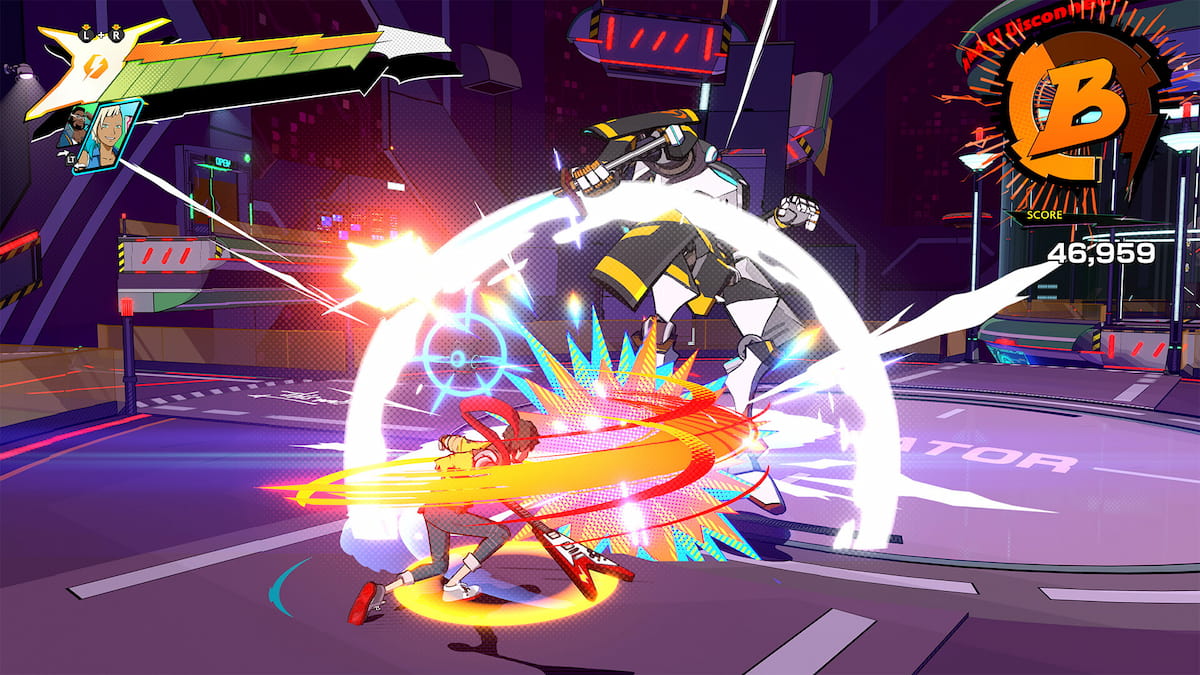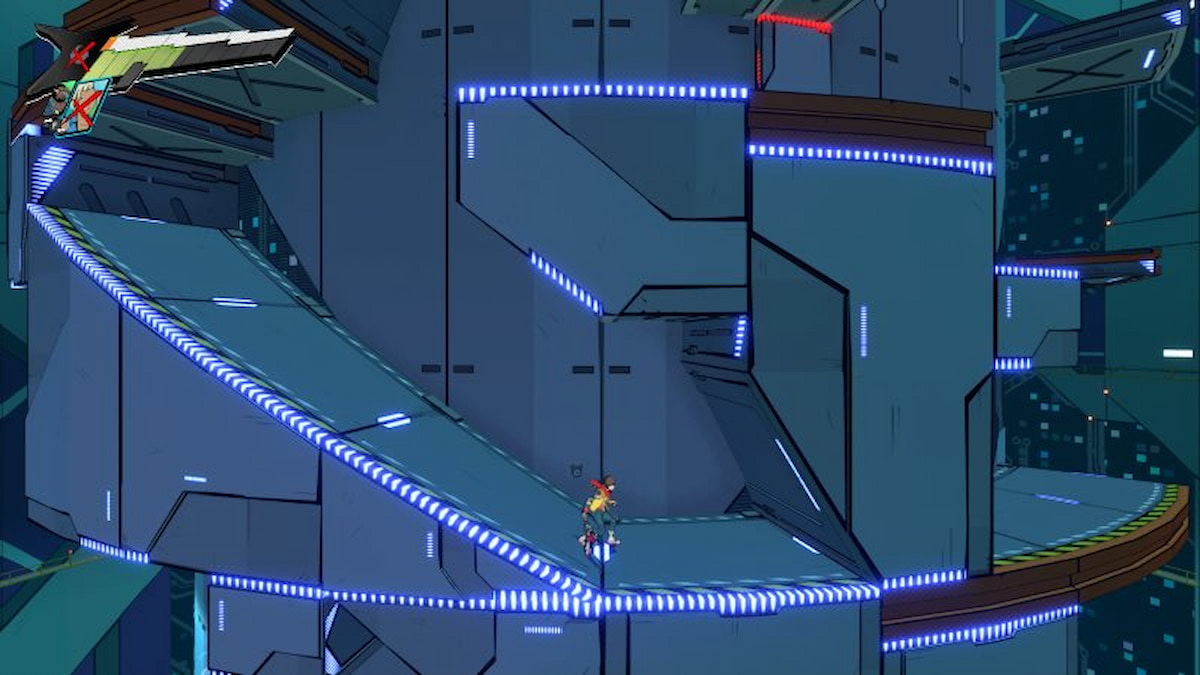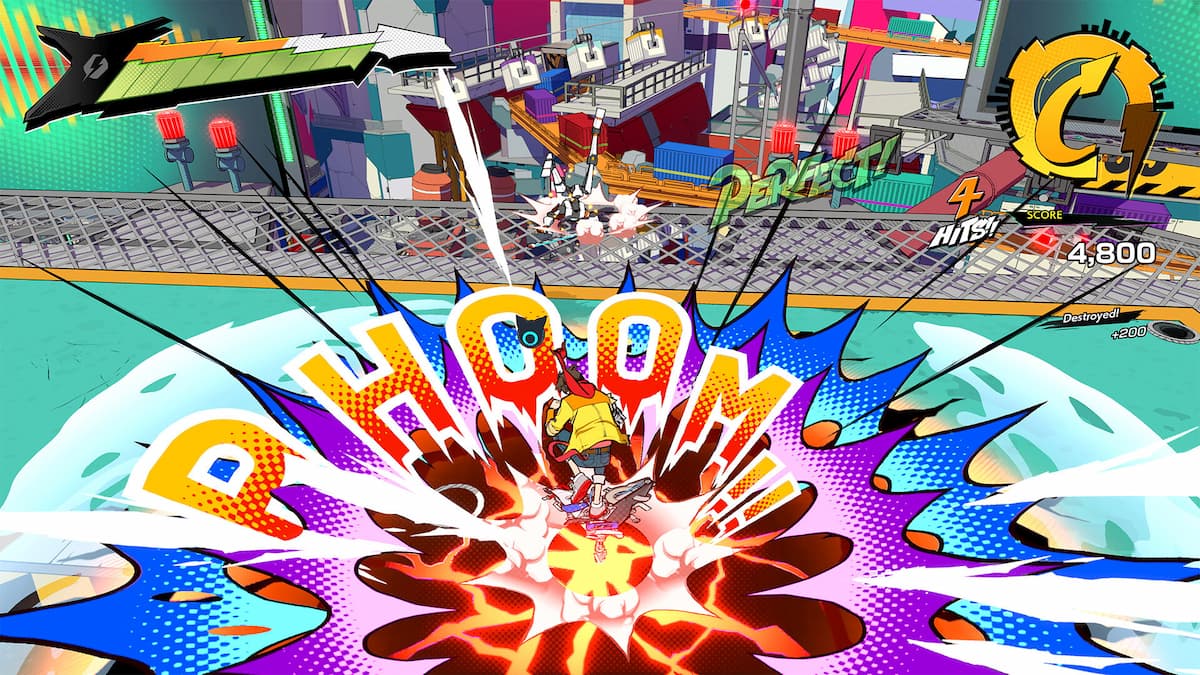Like so many others, I still find it surreal that Hi-Fi Rush even exists. Released only a few hours after its announcement, Hi-Fi Rush boasts a core concept that seems almost tailor-made to cater to my interests with its combination of rhythm-based gameplay and 3D action combat in the vein of Devil May Cry or Bayonetta. With a slick, cel-shaded style serving as the cherry on top, Hi-Fi Rush appeared almost too good to be true in many ways. Regardless, I went in with reserved expectations, not quite sure if the game would live up to its promise. But what feels most surreal of all is that it absolutely does. To put it simply, Hi-Fi Rush rules, and anyone with even a passing interest in this game should try it as soon as they can.
Feel the rhythm of combat
So how does Hi-Fi Rush go about mixing together brawler- and rhythm-game elements? For starters, every action you and the enemies take, whether it be an attack, dodge, or parry, is synced up to whatever music track is playing in the background. So even if you go into a fight mashing the attack button, your moves will come out in a satisfying rhythmic sequence. This means that even those without a sense of rhythm can immediately derive some enjoyment from Hi-Fi Rush‘s synesthetic gameplay systems.
This all sounds well and good, but doesn’t this mostly amount to a mere aesthetic flourish? While it’s true that players can progress through Hi-Fi Rush mostly fine by treating it as a standard action game, you won’t be able to make the most out of the combat system this way. The game encourages you to hit the attack buttons in time to receive various bonuses in battle, such as higher damage output and powerful Beat Hit finishers.
It’s the small things
Just this idea alone is enough to make the combat compelling on a visceral level, but several other smart details push it that much further. Combo strings are governed by a consistent, intuitive system in which light attacks come out one beat after the button press whereas heavy attacks happen two beats after. Not only does the extra beat of windup before a heavy attack go a long way toward selling the power of the move, but it also encourages players to pay closer attention to the rhythm and break away from the habit of repetitively hitting the attack buttons on every beat. With this simple touch, executing combos in Hi-Fi Rush feels less like you’re simply memorizing a list of button inputs and more like you’re playing an actual song.
Another element that aids the rhythm-based combat is the visuals’ synergy with the soundtrack. Almost every environmental background asset bounces and bobs to the beat, which means players have a whole host of visual cues to ensure they stay in rhythm. As if that wasn’t enough, your cat companion 808 emits a small ring that pulsates on every beat. And even Chai, the player character, times his footsteps to the music and snaps his fingers when left idle. This decision to design the entire game world as a makeshift metronome is an ingenious method for getting players to more easily internalize the rhythm while fighting, even without the game’s actual metronome feature you can optionally turn on.
Not just your average brawler
The rhythm aspects may serve as Hi-Fi Rush‘s main draw, but don’t think for a second that the developers prioritized the novelty of its premise over its gameplay complexity. This is a serious action game, complete with a wide variety of options for both offense and defense, different enemy hit reactions for players to take advantage of, and intricate setups for advanced combo strings. Veterans of action games will no doubt recognize several tropes of the genre included in Hi-Fi Rush. There’s a grappling feature reminiscent of Nero’s Buster and Wire Snatcher from the Devil May Cry series, as well as the combo finishers that echo Bayonetta‘s Wicked Weaves.
Some may end up comparing the game’s systems to those of other action titles to see how they stack up in terms of depth. But really, whether or not Hi-Fi Rush is as deep as this or that game isn’t important. The fact that it even comes close is a remarkable achievement in and of itself, especially considering the limitations that come with having to match the pacing of the background music.
A perfect marriage of genres
In many ways, Hi-Fi Rush serves as an effective entry point into the action genre, and not just because of its myriad accessibility options. Interestingly enough, the rhythm elements of the game play a huge part in this. They actually add a level of consistency to the combat that could potentially make it easier for players to grasp common action game elements they may otherwise find obtuse or difficult to grow accustomed to.
Take the rest combos, for example. Many action games feature special combo strings that players can only perform by waiting for a brief moment between certain inputs. It’s a great way to give the player more attack options without using any extra buttons, but the amount of time you need to wait between inputs may be unclear to some. I know that I had trouble consistently performing rest combos in Bayonetta partially for this reason. However, thanks to the rhythm-based nature of Hi-Fi Rush, there’s no ambiguity to the rest combo timing at all. You simply wait for one beat between two inputs, and the rest combo will trigger just like that. The game even includes a “Rest” visual indicator to drive this home.
“Not quite my tempo”
Dodging and parrying is another big one. Much like other action games, Hi-Fi Rush incentivizes you to dodge or parry right when an enemy attack is about to hit you for some added benefits. In other titles, though, it may be easy to blame a mistimed parry or dodge on a wonky hitbox or some other issue, whether that’s actually the case or not.
But since enemies in Hi-Fi Rush always attack on the beat, it’s almost always clear why a particular parry or dodge may not have worked. Just following the rhythm is often all you need to do to correct yourself.
It’s not all Guns n’ Roses
This is not to say that fighting enemies is always perfect. Hi-Fi Rush features several enemy types with shields or other gimmicks that are meant to be neutralized by calling out one of your partners. On their own, the game’s partner abilities do a fantastic job at expanding the player’s combat options. But their usage in this case feels somewhat rote, and there’s a bit of an overreliance on these enemy types throughout the adventure.
Granted, this ended up nowhere near as groan-worthy as it could have been. The game lets you instantly break enemy shields using one of the special attacks performed with the Reverb Gauge, completely eliminating the need for your partners. Additionally, the cooldowns for each use of your partner are mercifully brief most of the time. But if you go into a fight with exclusively shielded enemies and you don’t have a reserve battery to fill up your Reverb Gauge, the need to repeatedly use your partners can nonetheless bog down the pacing a bit.
The beat is all around you
Speaking of pacing, Hi-Fi Rush follows in the footsteps of other 3D brawlers by including platforming and exploration segments to break up the action. These moments in other action titles can often feel like going through the motions, and while Hi-Fi Rush doesn’t entirely avoid this, the rhythm aspects do help them stand out a lot more than they would otherwise.
Just like the rest of the game, platforms and obstacles match the beat of the music, which leads to some fun and creative moments of environmental traversal. Both in and outside of combat, Hi-Fi Rush is remarkably effective at pulling you into its wavelength, so much so that I found myself regularly timing my jumps to the beat even though there’s no reason to do so when not in battle.
Bouts to remember
The game is especially good at doing this during the boss encounters. These bouts are expertly staged, boasting infectiously energetic visual designs as well as brilliant use of licensed tracks that dynamically change across phases. It certainly helps that the fights themselves serve as fantastic skill challenges, testing players’ ability to dodge and parry to the music as well as maximize damage output.
As good as these fights are, the way in which they’re spread throughout the game is a bit strange. For the most part, the bosses are stuffed in the early and latter parts of the campaign, with a huge stretch in the middle being devoid of boss fights entirely. During my playthrough, this led to a feeling of restlessness as I wondered when the next big setpiece battle would finally happen. So the pacing could have seen some improvement in that regard. Thankfully, once the boss fights do start cropping up again, they’re well worth the wait. In particular, the last two fights are, excuse my French, fucking awesome, and they left me in an absolutely euphoric state the whole way through.
These amazing moments are propped up by a story that’s much more entertaining than I expected it to be. To be clear, it’s not a deep narrative by any means, and you can see the game’s major twists coming from a mile away. But it has a great sense of fun and lands where it counts, and despite the often self-aware humor, it’s refreshingly sincere to boot. Topping everything off is the overall solid voice acting and insanely expressive animation that oozes style in every frame.
Some preparation may be needed
Before jumping into Hi-Fi Rush, it’s important to note that while the PC requirements aren’t all that high, they’re not that low either. And even if your PC meets the minimum requirements for the game, it still may not be ideal since a smooth, consistent framerate is crucial for the gameplay of Hi-Fi Rush. My lower-end PC was unable to boot up the game outright, so I had to stick to a higher-end PC instead, which ran the game mostly flawlessly. There were a few bugs I ran into, including one that locked me from the second stage until I booted up the game again, but these will likely vary depending on the player.
In the end, it’s still almost hard to believe just how good Hi-Fi Rush turned out. Not only does it execute the idea of a rhythm-based brawler almost perfectly, but it also feels remarkably uncompromising in its vision. The combat could have simply given players a handful of combos, some special attacks, and a few other miscellaneous abilities, and it still would have been a pretty good game just from the rhythm aspects alone. But its decision to fuse those rhythm elements with combat that arguably rivals the best in the action genre pushes it to a new level entirely. In short, you definitely don’t want to miss this one if possible.











Published: Feb 2, 2023 06:43 pm